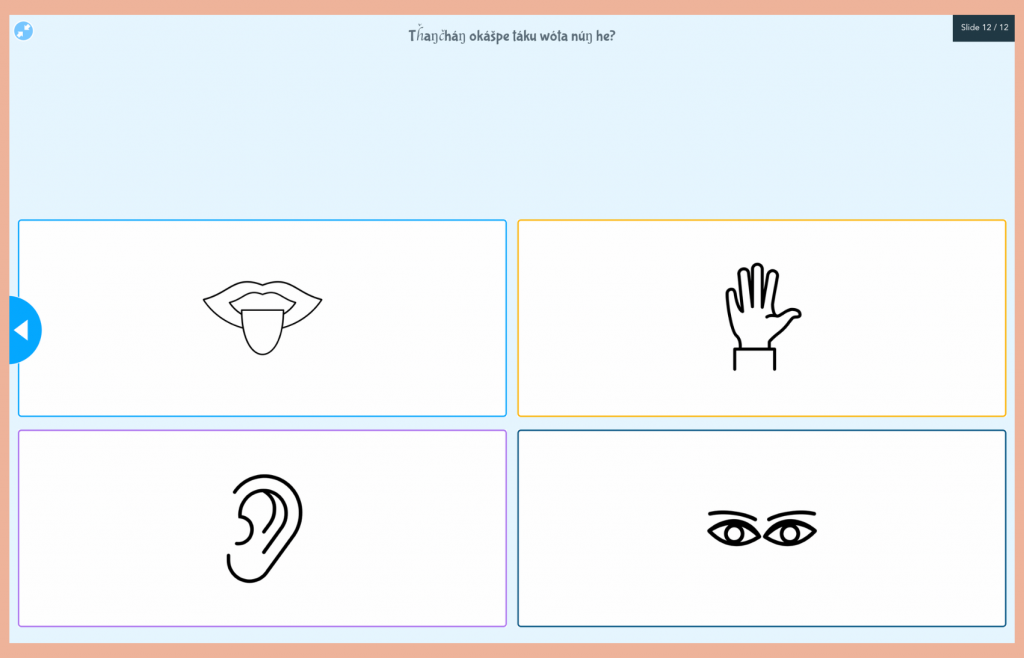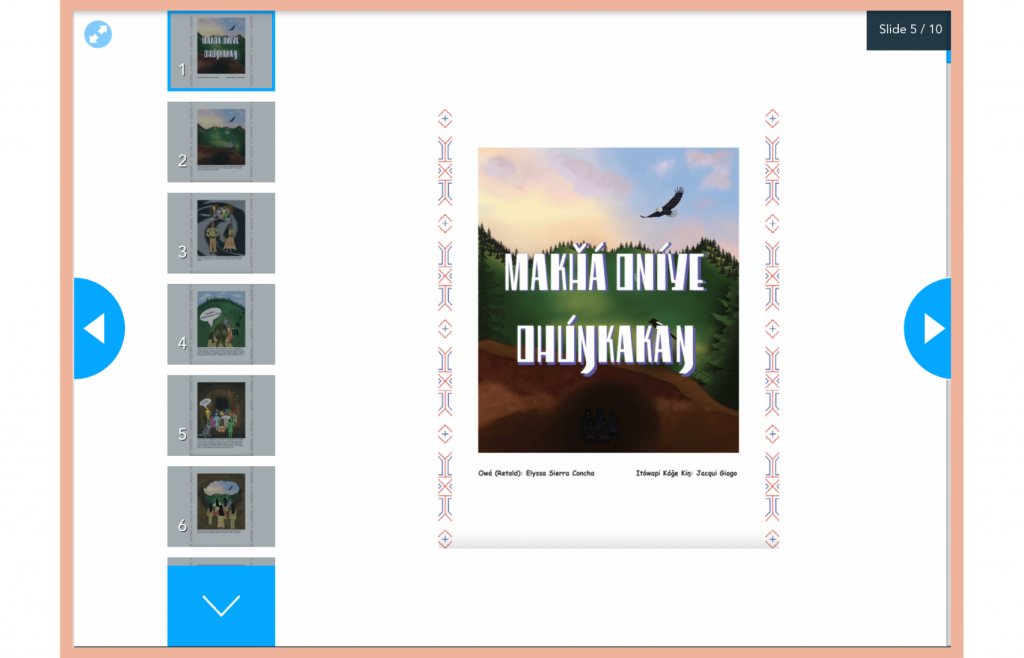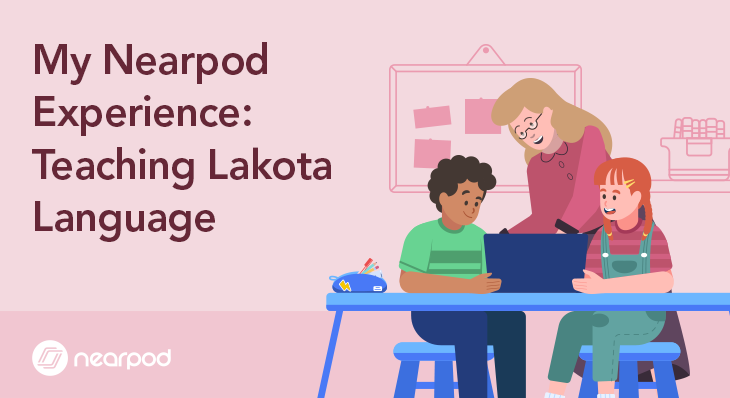
My Nearpod Experience: Teaching Lakota Language
The educators at Red Cloud Indian School who are teaching the Lakota language have been using Nearpod daily to develop lessons that range from kindergarten curriculum to adult Lakota language classes. The Lakota language is the indigenous language of the Lakota people. Since the boarding school era (the 1860s to the 1970s), the Lakota language has been in danger of going extinct. Drastic measures had to be taken in recent years to revitalize the language.
Lakota language immersion means that our students are completely immersed in the Lakota language while at school. They learn math, social studies, science, reading, and writing all in Lakota.
Nearpod allows Lakota immersion educators the freedom to develop lessons in the language through entertaining activities for all our students. Nearpod also provides a variety of lessons that educators can save and translate into the Lakota language. Students of all ages access our Nearpod lessons almost every day of the week. Each Lakota language immersion educator has created hundreds of Nearpod lessons over a few years, and we continue to make more every day.
The importance of teaching Lakota language
The history of education and Indigenous peoples must be understood to fully grasp the importance of teaching the Lakota language and teaching Lakota language immersion. Indigenous peoples’ first introduction to the education system was boarding schools built in the late 1800s. Colonel Richard H. Pratt stated the mission of these schools and infamously said, “Kill the Indian, save the man.” Such a short and straightforward statement molded the foundation of the education system society continues to use to this day. Indigenous knowledge systems and languages were silenced due to the education system working to industrialize and assimilate Indigenous peoples.
The effects of that era, which ended in the ’80s, are still prominent in tribal communities. There are only a few thousand fluent Lakota language speakers today. This is a small number compared to over 40,000 Lakota enrolled tribal members. Reimagining the education system through language revitalization has proven successful for all students and educators involved. The Lakota language immersion curriculum is entirely a culture-based education implementing culturally sustaining pedagogy. Through this program, we are working towards guiding this young generation and the ones to follow to be fluent in the Lakota language and knowledgeable of cultural teachings.
How Nearpod helped us jumpstart the curriculum
We, the Lakota immersion educators of Red Cloud Indian School, discovered Nearpod around the summer of 2020, the pandemic’s beginning. The only Lakota immersion curriculum we had developed up to that point was not accessible online. At first, educators were told that this would only last some weeks, so we printed out as much work as possible for students to take home. Since it was so early on in the pandemic, society did not yet know how COVID-19 was transmitted, so continuing to pass out workbooks and activities for families to pick up was not an option. We began searching for online-friendly lessons that could be created and manipulated to use Lakota language words with the goal of developing a virtual curriculum solely in the language. Educators could access interactive sites in English, but finding sites that would allow Lakota language immersion educators to manipulate and create lessons proved to be more difficult.
When discovering Nearpod, our school held meetings online for educators to learn more and help each other become familiar with developing lessons on the platform. At the time of March 2020, I was teaching kindergarten, so my biggest concern was keeping my students engaged while successfully teaching them new concepts. I would share videos I made of myself discussing our worksheets and teaching the curriculum. Eventually, the school required that all teachers host video meetings with their students every day. We were slowly improving as a school and adjusting to online learning. However, teaching the Lakota language and teaching within the language remained a huge obstacle for parents as many did not know the language. A radical change quickly became necessary for students to continue learning and staying in the immersion program.
We decided to develop our curriculum from scratch for better accessibility. My colleagues and I have since developed lessons for kindergarten through fifth grade in all subjects, including language arts, math, social studies, and science. We also developed Nearpod lessons for teaching Lakota language oral proficiency for grades K-4.
Red Cloud Indian School remained virtual for most of the school year of 2021-2022. All educators were required to teach during regular school hours, developing multiple interactive lessons five days a week.
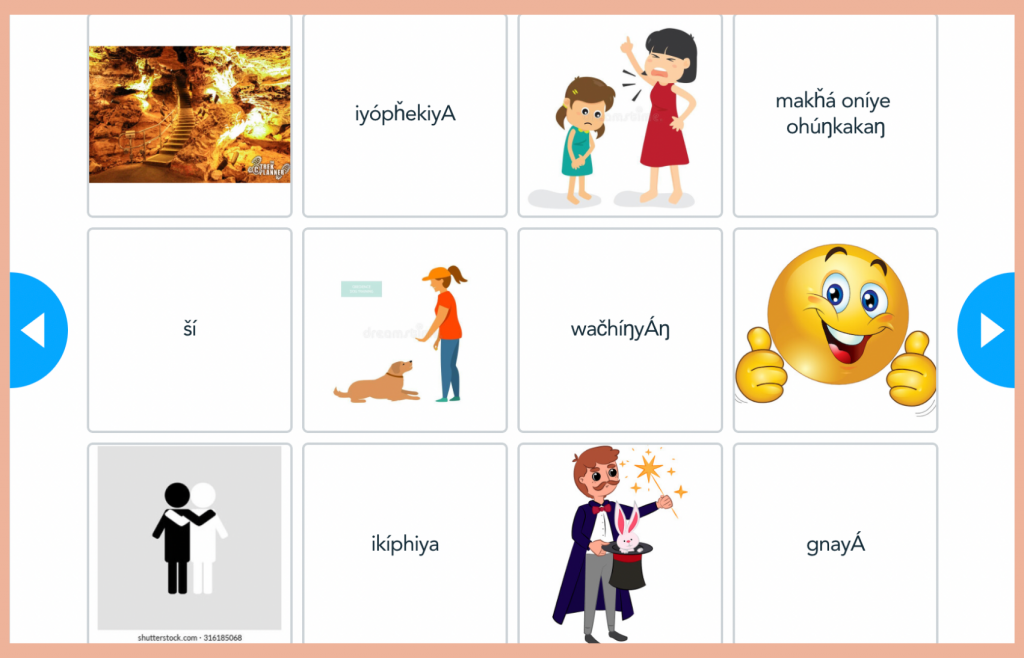
As young as five years old, students learned how to access and navigate Nearpod through school tablets safely distributed before school. Nearpod provides a variety of activities, which helped maintain their focus and curiosity. All the activities are child-friendly, so telling them to press “the big blue button” to submit their work was quickly learned.
Interactive slides, videos, and formative assessment activities
Lakota language immersion educators could introduce a new topic through interactive videos and slides and check for understanding using interactive activities. Nearpod serves as formative assessments, sometimes asynchronous lessons, and teacher-led lessons for our students. Here’s how we formatted our lessons:
- We use interactive slides as an introduction by adding essential information.
- Then, throughout the lesson, we use various interactive activities to keep students engaged and learning. Example: Matching Pairs
- To wrap up, we use Nearpod’s formative assessment tools to check for understanding. Example: Quiz or a Time to Climb activity
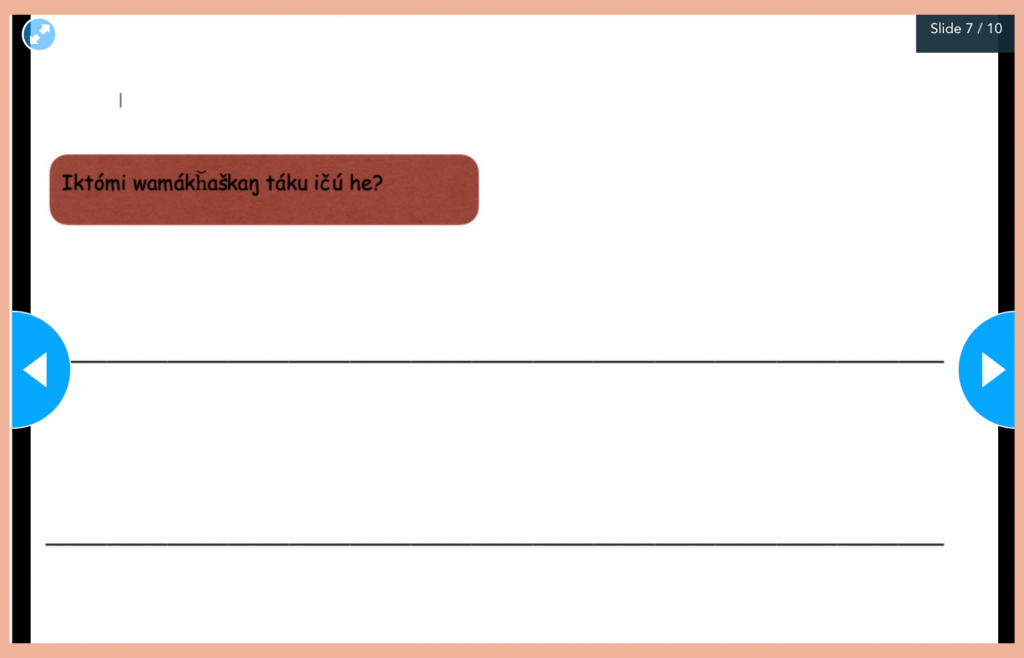
One activity, in particular, we were grateful for was Draw It. It serves as an open-ended question activity but allows students to write their responses. For example, in the Draw It instructions section, the educator will provide a question about the lesson, and the students will write the answers. Kindergarten students often use the Draw It activity to trace letters and words and then attempt to write the letters and words independently.
Our younger K-2 students, who still needed to practice and learn to write physically, were able to do so through the use of this activity.
Sharing and organizing lessons with colleagues
The students quickly grew to enjoy Nearpod and the various activities it provides. We educators at Red Cloud Indian School also favor it because we can easily share lessons and edit whatever is shared. Before Nearpod, all the work we created was often lost in our files. It was challenging to remember sharing or finding any curriculum we individually created.
With Nearpod, we can share editable links or share entire folders of our lessons using the library, something we all do weekly. It has been great to share editable links to our lessons. We all teach different grades, so we can use similar content and adapt activities to fit appropriate grade levels. We all enjoy it so much that even after our school transitioned to hybrid and eventually entirely in-person, we continue to use Nearpod in everyday lessons.
Modifying lessons for different grade levels and hybrid learning
Finding resources that adhere to younger grades’ needs is difficult. Still, Nearpod provides a variety of activities that can be adapted for all ages. For K-2 specifically, our educators use the Draw It activity every day to increase writing and drawing skills. Drag & Drop, Matching Pairs, Fill in the Blanks, and Time to Climb all serves as a tool to increase Lakota language fluency and master core curriculum skills and knowledge. Lakota language immersion teaches to South Dakota’s content core standards, so the students are learning skills as every other K-2 student is learning but in the Lakota language. In addition, we focus on Lakota teachings and culture throughout the school year. Grades 2-5 also use Nearpod every day and use the activities just mentioned and utilize Open-Ended Questions, Quiz, Poll, and Collaborate Board.
Teaching Lakota Language adult-level courses
My colleagues and I also teach adult Lakota language classes throughout the school year. In 2020 we chose to make the hybrid courses entirely virtual. The students from various states were not receiving the same materials and attention as those previously in person. This transition was well-received due to many of our students being located throughout the country. Also, our classes have grown now that all materials and lessons are accessible online. It allowed everyone to learn from their homes and do so in interactive ways.
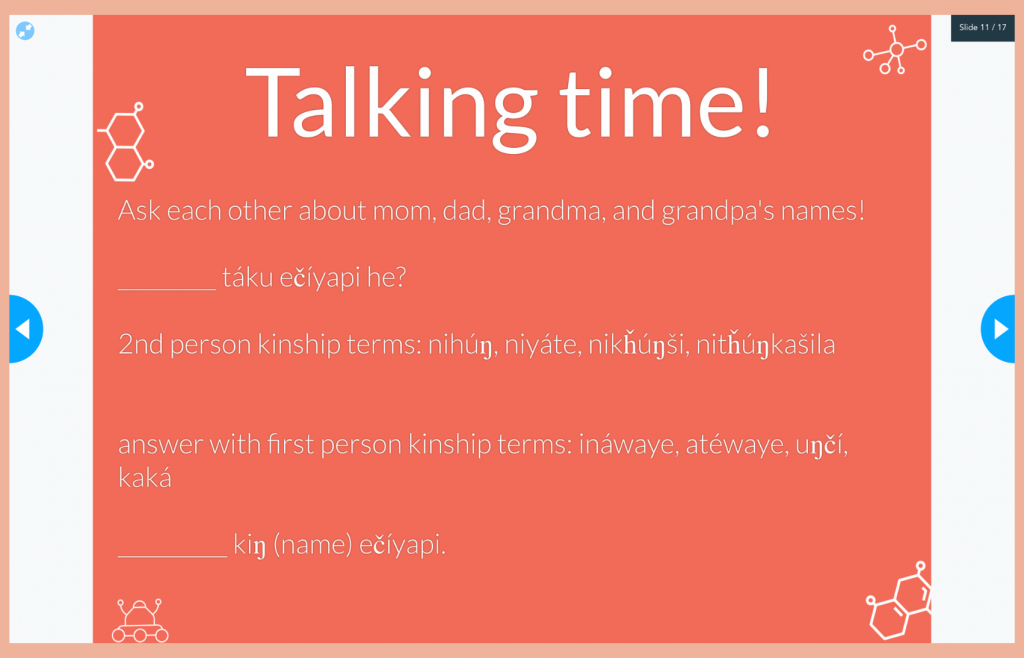
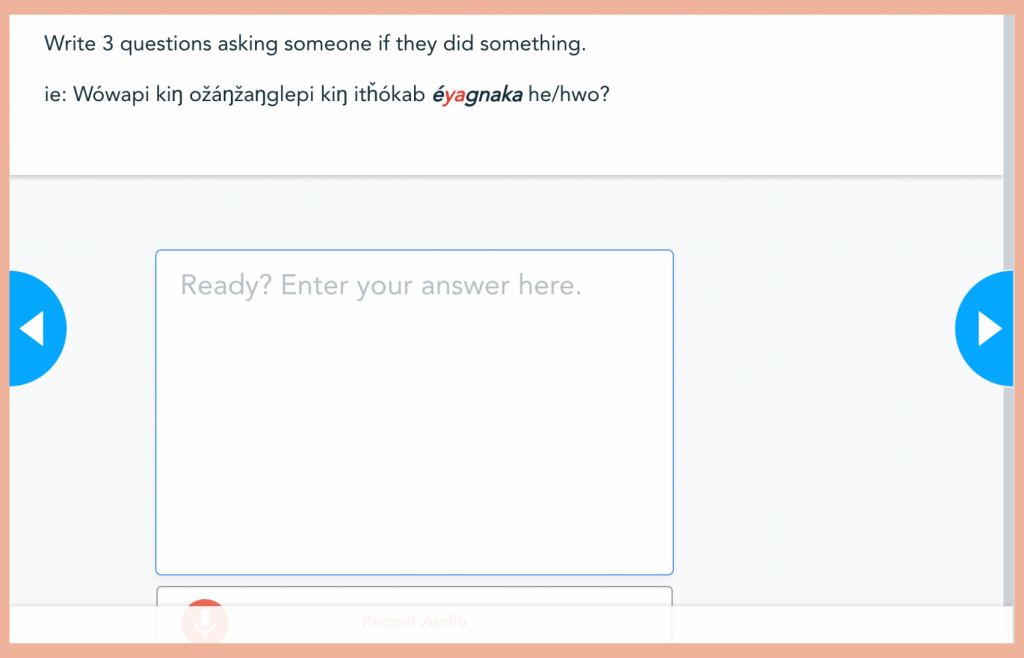
Teaching Lakota language to adults is vastly different from task teaching elementary. Still, we chose to use Nearpod, and the feedback from the adults has been very positive. The lessons in Nearpod are just as engaging for adults as they are for younger students. Nearpod has various lesson launch modes, such as Live, Student-Paced, and Front of Class. Student-Paced mode allows students to go back and review lessons in case they missed class. There are currently four levels of adult Lakota language classes being taught virtually, which are all free. All materials and lessons are provided and are sent to students daily due to the self-paced option Nearpod provides.
My colleagues and I began teaching adults because it became clear as we taught elementary that we would need more Lakota language immersion teachers as our program progressed. We also recognized that while our efforts toward reclaiming and revitalizing the Lakota language through our youth were working, we also wanted to achieve the same goal with older generations.
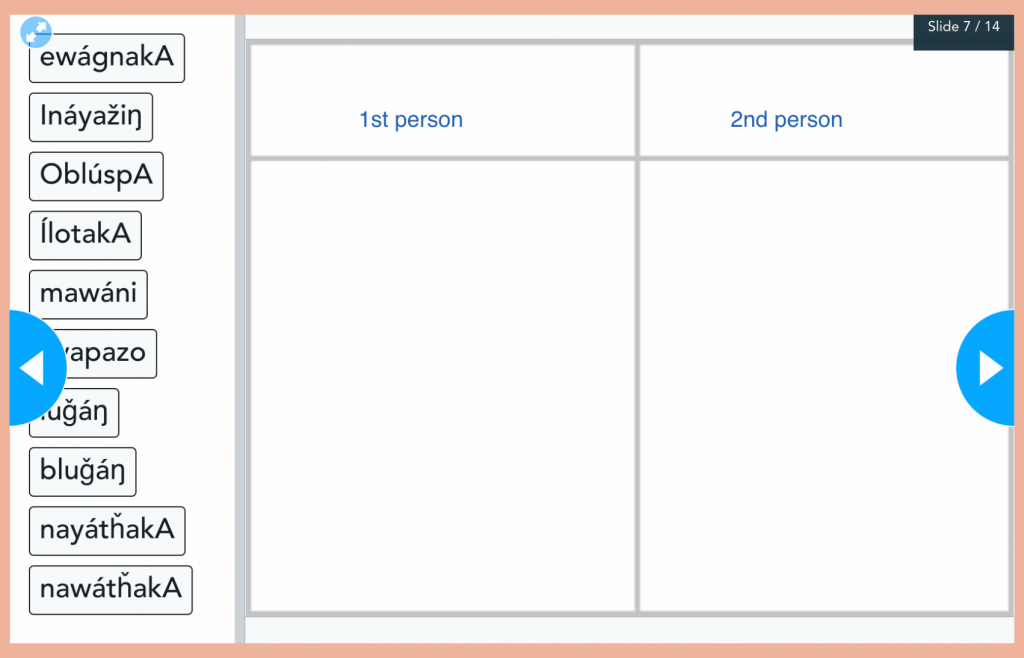
Our adult Lakota language classes have students as young as 16 and in the age range of the ’60s. Teaching immersion is very different from teaching adults because we are teaching in the language for our immersion program, but for our adult classes, we are teaching them the language. Teaching Lakota language to adults has become a fun and exciting experience, and they thoroughly enjoy all Nearpod activities, particularly Time to Climb.
This activity has served as a release of stress after an entire class of studying and learning. The students see it as a friendly competition, and it serves as a good assessment for us educators to see how well they have retained what was taught in class. Students have expressed their joy in learning the language virtually and are continuously excited to see their own progress every year.
We use every activity offered within Nearpod lessons every week for our adult language classes. We specifically use Fill in the Blanks, Matching Pairs, and Drag and Drop for vocabulary lessons. We use Open-Ended Questions, Draw It, Quiz, and Poll for assessments and activities regarding sentence structures and writing fluency. We also use the interactive slides every class to introduce new concepts and vocabulary. It also serves as instructions for “talking time,” when they are required to speak with each other in Lakota based on a prompt we have provided.
The impact of teaching Lakota Language
Students in our K-5 immersion program and our adult Lakota language classes continue to master their skills. Our K-5 students test at and above the national average in standardized testing, and our students in adult Lakota language classes have significantly improved since we decided to use Nearpod. Students in the highest level of adult Lakota language classes are at different levels of fluency now, and thanks to the self-paced option, students can review and study outside of class hours. Nearpod has been an incredible resource in teaching Lakota people of all ages and reclaiming and revitalizing our Lakota language.
Teaching Lakota language to various ages is challenging, but we are grateful to have found a tool to do so in a fun way effectively. Nearpod has been so valuable throughout the pandemic and virtual education. Educators and administrators worldwide were faced with an obstacle no one had ever experienced before. It was and continues to be a difficult time for many these past few years. Still, our students are resilient, and finding resources such as this has helped our students remain academically challenged and encouraged them to master educational standards. Our students continue to enjoy this platform to this day. We will continue to include Nearpod in our lessons as our Lakota language immersion, and adult Lakota language curriculum grows.
Interested in reading more about this topic? Check out this blog post: Experiential Learning for ELL Newcomers

Sierra is the Project Coordinator of the Lakota Language Literacy Project K-8 at Red Cloud Indian School. She graduated from Black Hills State University in 2018 with a B.S in English and graduated from Arizona State University in 2021 with a M.A. in Indigenous Education. She taught kindergarten Lakota language immersion for two years and first grade Lakota language immersion for one year.
